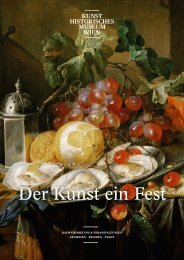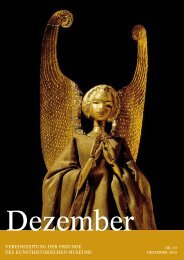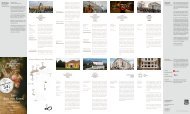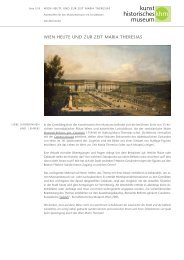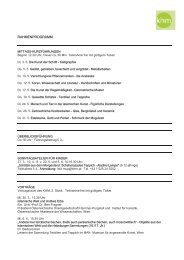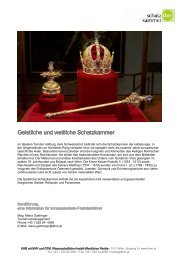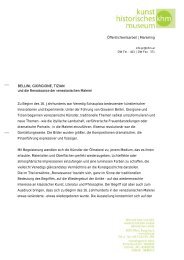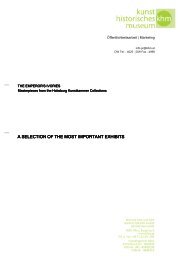Vermeer „Die Malkunst“ - Kunsthistorisches Museum Wien
Vermeer „Die Malkunst“ - Kunsthistorisches Museum Wien
Vermeer „Die Malkunst“ - Kunsthistorisches Museum Wien
Erfolgreiche ePaper selbst erstellen
Machen Sie aus Ihren PDF Publikationen ein blätterbares Flipbook mit unserer einzigartigen Google optimierten e-Paper Software.
Claes Jansz. Visscher<br />
Map showing the 17 Provinces<br />
Consists of 9 parts<br />
17th century<br />
111 x 153 cm<br />
Paris, Bibliothèque nationale<br />
Credit line: „Cliché Bibliothèque nationale de France“<br />
Claes Jansz. Visscher’s “Map of the 17 Provinces” is identical to the one depicted on the back wall of the studio in<br />
<strong>Vermeer</strong>’s “The Art of Painting”. The painted map is facing west and shows the Netherlands before the separation<br />
of the country finalised in 1648; this has given rise to political interpretations of the work that are discussed in the<br />
exhibition. The illusionism of the coloured map in the painting is a wonderful example of virtuosity of <strong>Vermeer</strong>, who<br />
dissolves the graphic model into light and colour. The twenty townscapes framing the map (see, for example, the<br />
view of Amsterdam by Claes Jansz. Visscher) also document this. All the prints depicted in the painting are<br />
included in the exhibition, allowing visitors to compare them with their depiction in the painting for the first time.<br />
Kronleuchter mit acht Armen<br />
2. Viertel 17. Jh.<br />
© Mecheln, Stedelijke Musea<br />
Ein in der Ausstellung gezeigter Leuchter aus Mecheln<br />
entspricht demselben Typus wie derjenige, den<br />
<strong>Vermeer</strong> in der „<strong>Malkunst“</strong> dargestellt hat. Der Aufsatz<br />
mit dem Motiv des Doppeladlers regte zu zahlreichen<br />
historischen, konfessionellen und biographischen<br />
Interpretationen an, denen in der Ausstellung<br />
nachgegangen wird. (So wird hier vor allem die<br />
Richtigkeit der Identifizierung des Doppeladlers als<br />
Emblem der Habsburger in Frage gestellt.) Zudem<br />
macht der pastose Farbauftrag das Motiv des<br />
Kronleuchters zu einem unvergleichlichen<br />
künstlerischen Bravourstück. Im Streiflicht<br />
aufgenommene Photographien dieses Details verdeutlichen <strong>Vermeer</strong>s verblüffende Malweise.<br />
Chandelier<br />
2nd quarter of the 17th century<br />
© Mecheln, Stedelijke Musea<br />
The chandelier from Malines on show in the exhibition is identical to the one depicted in <strong>Vermeer</strong>’s “The Art of<br />
Painting”. Its double-headed eagle inspired countless historical, denominational and biographical explanations that<br />
are discussed in the exhibition. (We question the identification of this double-headed eagle as an emblem of the<br />
House of Habsburg). The open brushwork turns the chandelier into a unique example of <strong>Vermeer</strong>’s bravura<br />
handling. Photographs of this detail taken in raking light illustrate his incredible technique.<br />
10





